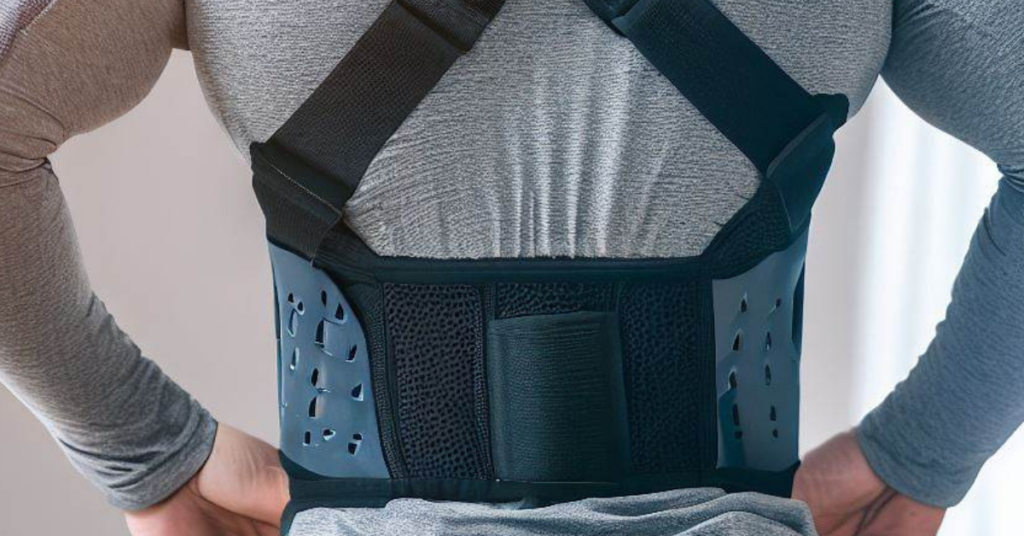Best Brace for Sciatica Nerve Pain : 5 Factors to consider
Where is the Sciatic Nerve Located?
The sciatic nerve runs deep within the buttocks and travels down the posterior aspect of the thigh. It then divides into two major branches, the tibial nerve and the common fibular (peroneal) nerve, which further supply the muscles, skin, and joints of the lower leg and foot.
The sciatic nerve follows a path from the lower spine, through the buttocks and back of the thigh, all the way to the lower leg.
Signs and Symptoms of Sciatica Nerve Pain
When the sciatic nerve becomes compressed or irritated, it can result in a condition known as sciatica. Sciatica nerve pain typically manifests as a sharp, shooting pain that radiates from the lower back, through the buttocks, and down the back of one leg.
The pain may extend all the way to the foot or may be concentrated in certain areas along the nerve pathway.
Other common signs and symptoms of sciatica include:
1. Numbness or tingling sensation along the sciatic nerve distribution, which can affect the buttocks, back of the thigh, calf, and foot.
2. Muscle weakness in the leg or foot, making it difficult to move or control certain muscles.
3. Burning or searing pain that worsens with prolonged sitting, standing, or movement.
4. Radiating pain that intensifies with activities such as coughing, sneezing, or straining.
5. Difficulty walking or experiencing a “pins and needles” sensation in the affected leg.
It’s important to note that sciatica can vary in severity, ranging from mild discomfort to debilitating pain. If you experience persistent or worsening symptoms of sciatica, it’s advisable to consult a healthcare professional for a proper diagnosis and guidance on appropriate treatment options.
Understanding Sciatica and Its Symptoms
Before diving into the details of braces, it’s essential to understand what sciatica is and how it manifests. Sciatica refers to the irritation or compression of the sciatic nerve, often resulting from a herniated disc, spinal stenosis, or other underlying conditions.
The most common symptoms of sciatica include sharp, shooting pain in the lower back, buttocks, and legs, numbness, tingling sensations, and muscle weakness.
Importance of a Brace for Sciatica Nerve Pain

A brace designed specifically for sciatica nerve pain can provide several benefits to individuals suffering from this condition. It offers support and stability to the lower back and pelvis, helps alleviate pressure on the sciatic nerve, promotes proper alignment, and reduces pain during daily activities and movement.
Wearing a brace can also provide a gentle reminder to maintain good posture, which is crucial for relieving sciatica symptoms.
5 Factors to Consider When Buying a Brace
When selecting a brace for sciatica nerve pain, it’s important to consider various factors to ensure its effectiveness and comfort. Let’s explore these factors in detail:
1. Types of Braces for Sciatica:
- Lumbar Support Braces
- Sacroiliac Belts
- Compression Shorts
- Wraparound Braces
2. Finding the Right Fit and Size:
- Measure your waist and hip circumference
- Refer to the manufacturer’s sizing guide
- Choose a brace that provides a snug and comfortable fit
3. Materials and Comfort:
- Look for breathable and moisture-wicking materials
- Consider soft padding or cushioning for added comfort
- Ensure the brace is lightweight and doesn’t restrict movement
4. Adjustability and Support:
- Opt for a brace with adjustable straps or closures
- Look for braces that provide targeted support to the affected area
- Consider braces with removable inserts or pads for customization
5. User Reviews and Recommendations:
- Ensure the brace is lightweight and doesn’t restrict movement
- Read customer reviews and testimonials
- Seek recommendations from healthcare professionals or individuals with similar conditions
- Consider the overall reputation and reliability of the brand
Finding the Right Fit and Size
Finding the right fit and size is crucial when choosing a brace for sciatica. Here are some tips to ensure a proper fit:
Measure your waist and hip circumference:
Use a measuring tape to accurately measure your waist and hip size. This will help you determine the appropriate size range for the brace.
Refer to the manufacturer’s sizing guide:
Each brace manufacturer typically provides a sizing guide that correlates waist and hip measurements with the corresponding brace size. Follow the instructions provided to select the right size.
Choose a brace that provides a snug and comfortable fit:
It’s important to choose a brace that fits snugly around your waist and hips without being too tight or restrictive. A comfortable fit ensures effective support and minimizes discomfort.
Materials and Comfort
Consider the materials used in the construction of the brace and prioritize comfort. Here are some factors to consider:
Look for breathable and moisture-wicking materials:
Sciatica braces made from breathable materials allow proper air circulation, reducing the risk of sweat buildup and discomfort. Moisture-wicking fabrics help keep your skin dry.
Consider soft padding or cushioning for added comfort:
Some braces feature additional padding or cushioning in key areas, such as the lower back or hip region, providing extra comfort and support.
Ensure the brace is lightweight and doesn’t restrict movement:
Opt for a brace that is lightweight and allows freedom of movement. This ensures that you can wear it comfortably throughout the day without feeling restricted or hindered in your activities.
Adjustability and Support

Look for a brace that offers adjustability and targeted support to address your specific needs.
Here’s what to look for:
Opt for a brace with adjustable straps or closures:
Adjustable straps allow you to customize the level of compression and support based on your comfort and requirements. They also enable you to easily adjust the brace as needed throughout the day.
Look for braces that provide targeted support to the affected area:
Different braces offer varying degrees of support to the lower back and hip region. Choose a brace that specifically targets the sciatic nerve area to provide optimal support and pain relief.
Consider braces with removable inserts or pads for customization:
Some braces come with removable inserts or pads that can be adjusted or repositioned to provide additional support where it’s most needed. This customization allows you to tailor the brace to your individual requirements.
User Reviews and Recommendations
It’s always helpful to gather insights from other users and healthcare professionals.
Here are some suggestions:
Read customer reviews and testimonials:
Check online platforms, such as e-commerce websites or healthcare forums, for reviews and feedback from individuals who have used the braces you’re considering. Pay attention to their experiences, both positive and negative, to make an informed decision.
Seek recommendations from healthcare professionals or individuals with similar conditions:
Consult with a healthcare professional, such as a physical therapist or orthopedic specialist, for their expert advice and recommendations. Additionally, connect with individuals who have experienced sciatica and ask for their suggestions and insights.
Consider the overall reputation and reliability of the brand:
Research the reputation and credibility of the brand manufacturing the brace. Look for brands that have a history of producing high-quality products and prioritize customer satisfaction.
Recommended Remedies for Sciatica Pain
In addition to using a brace, there are several remedies and self-care practices that can help alleviate sciatica pain. Here are some recommendations:
Stretching and Strengthening Exercises:
Engage in regular stretching and strengthening exercises that target the lower back, hips, and legs. Consult with a healthcare professional or physical therapist to learn specific exercises that can help relieve sciatica pain.
Hot and Cold Therapy:
Apply heat or cold packs to the affected area to reduce inflammation and provide pain relief. Alternate between hot and cold therapy by applying a heating pad or warm compress for 20 minutes followed by an ice pack or cold compress for another 20 minutes. This can help alleviate pain and reduce swelling.
Over-the-Counter Pain Relief:
Nonsteroidal anti-inflammatory drugs (NSAIDs), such as ibuprofen or naproxen, can provide temporary pain relief and reduce inflammation. Follow the recommended dosage and consult with a healthcare professional if you have any underlying health conditions or are taking other medications.
Maintaining Proper Posture:
Poor posture can aggravate sciatica pain. Pay attention to your posture, especially when sitting or standing for prolonged periods. Use ergonomic chairs, pillows, or lumbar supports to maintain a neutral spine position and reduce pressure on the sciatic nerve.
Gentle Activities and Rest:
Engage in low-impact activities, such as swimming or walking, to improve blood circulation and promote healing. Avoid activities that exacerbate the pain. Additionally, ensure you get enough rest and sleep to allow your body to recover, a good sleep position assists in reducing pain.
Seek Medical Advice
It’s important to note that while a brace and home remedies may provide relief for mild to moderate sciatica pain, they are not a substitute for professional medical advice. If you experience severe pain, sudden loss of bladder or bowel control, or progressive weakness in your legs, it’s crucial to seek immediate medical attention.
Always consult with a healthcare professional, such as a doctor or physical therapist, to receive a proper diagnosis and develop a comprehensive treatment plan tailored to your specific condition. They can provide guidance on the use of braces, recommend additional treatments or therapies, and monitor your progress.
Remember, each individual’s situation is unique, and what works for one person may not work for another. Be proactive in seeking professional advice and follow their recommendations for the best outcome.
Conclusion
Choosing the best brace for sciatica nerve pain requires careful consideration of factors such as fit, materials, adjustability, and user reviews. A well-fitted brace can provide support, stability, and pain relief, allowing you to engage in daily activities with greater ease.
However, it’s important to complement the use of a brace with other remedies such as stretching exercises, hot and cold therapy, over-the-counter pain relief, and maintaining good posture. These practices can contribute to overall pain management and enhance your well-being.
Remember, while self-care measures can be effective, it’s essential to consult with a healthcare professional if you experience persistent or severe pain. They can provide a comprehensive assessment, offer personalized recommendations, and guide you towards the most appropriate treatment options.
FAQs
1. Can I wear a brace all day long?
It’s generally safe to wear a brace for sciatica nerve pain during the day. However, it’s important to listen to your body and remove the brace if you experience discomfort or excessive pressure. Give yourself breaks when needed and follow the manufacturer’s recommendations for usage.
2. Can a brace cure sciatica?
A brace cannot cure sciatica. However, it can provide support and pain relief by reducing pressure on the sciatic nerve and promoting proper alignment. It’s important to combine the use of a brace with other treatments and lifestyle modifications for comprehensive management.
3. How long should I use a brace for sciatica pain?
The duration of brace usage varies depending on individual needs and the severity of sciatica pain. It’s best to consult with a healthcare professional who can provide guidance on the appropriate duration of brace usage based on your specific condition.
4. Are there any side effects of using a brace for sciatica?
When used correctly and with proper fit, side effects from using a brace for sciatica nerve pain are rare. However , it’s important to note that prolonged or improper use of a brace can potentially lead to muscle weakness or dependence on the brace. It’s recommended to follow the usage instructions provided by the manufacturer and consult with a healthcare professional for guidance.
5. Can I wear a brace while sleeping?
It’s generally not recommended to wear a brace while sleeping unless specifically advised by a healthcare professional. Sleeping without a brace allows your body to relax and move naturally during rest, promoting better blood circulation and reducing the risk of muscle stiffness.
The information provided in this article is not intended to substitute professional medical advice. If you experience persistent or severe sciatica pain, it is recommended to consult with a healthcare professional for a proper diagnosis and appropriate treatment.
![Urban Health Hive]](https://urbanhealthhive.com/wp-content/uploads/2023/05/cropped-cropped-Health_Logo.png)



